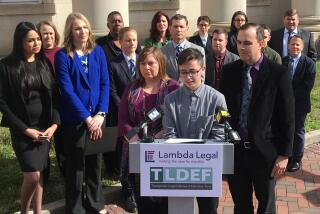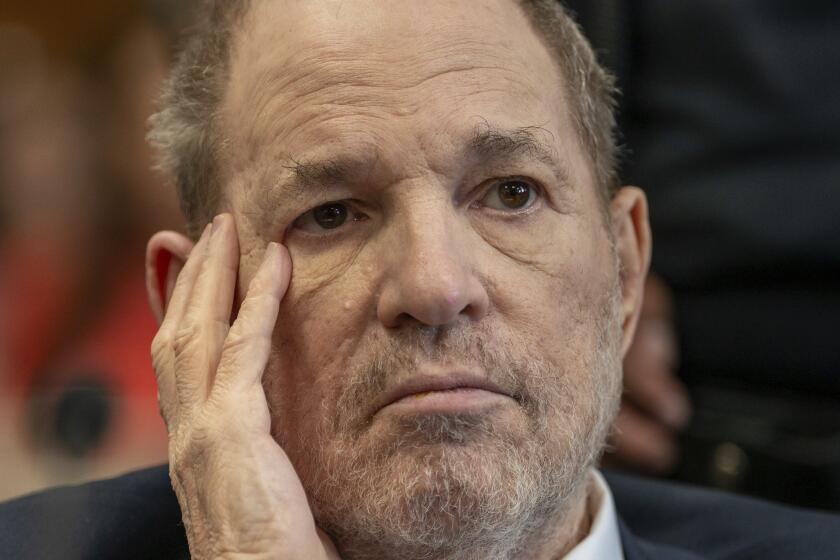Looser Trade Rules, Cheap Labor Fuel Texas-Mexico Border Boom
As Julio Madrigal surveys his hometown, the now-bustling Gateway to Mexico, he wistfully recalls the past, the endless fields of mesquite brush, rows of snow-white onions and hunting pastures roamed by scrappy wild pigs.
“It was a whole different kind of community,” says the 52-year-old native of Laredo.
Today, the onion fields are covered with houses, and the hunting grounds are home to the brand-new Texas A&M; International University, where Madrigal heads the department of psychology and sociology.
Mesquite still rustles in the torrid South Texas wind, but Madrigal wonders for how long.
“Look at all the brush out here. It’s beautiful,” he says. “You come back in three years, and there will be no brush.”
Today, La Frontera--the once-sleepy Texas-Mexico border--is awakening.
A metamorphosis is occurring all along the 700-mile stretch of the Rio Grande Valley from Brownsville to El Paso.
Looser trade restrictions and an abundance of cheap Mexican labor have lured more businesses and manufacturers to both sides of the river.
Over the last five years, the Texas side has become home to three of the 10 fastest-growing metropolitan areas in the country, the towns of Laredo, McAllen and Brownsville.
And if projections are correct, the Texas border has only begun to boom.
State demographers cite natural growth, spawned by a young population and high birthrates, as the primary cause of the population explosion. But Laredo City Manager Peter Vargas cites another factor: trade with Mexico.
More than one-third of all U.S. trade with Mexico is transported through Laredo.
“That’s really spurred the population growth,” Vargas says.
Laredo has swelled from 133,239 residents in 1990 to about 170,863 today.
The upswing started in the late ‘80s with the General Agreement on Tariffs and Trade and has continued with the North American Free Trade Agreement, Vargas says.
“We’re very adamant that NAFTA has helped,” he says. “We see it here on the border because it’s very visual, whereas in other parts of the country, it’s going on, but they just don’t see it and so they don’t understand it.”
The growth is indeed visual. From the tractor-trailers clogging the city’s three international bridges to the sounds of machinery working to expand the interstate highway and the ballet of cranes erecting still more buildings, development can be seen and heard all around.
Marina Sukup, director of Laredo’s planning department, ticks off a shopping list of projects: New department stores are coming, more hotels are opening, construction on a fourth international bridge starts this year, and the hospitals are on “a building marathon.”
In McAllen and its sister city to the south--Reynosa, Mexico--197 new companies opened and 45 businesses expanded in the last eight years, creating more than 50,000 jobs in both cities, said business consultant Michael Blum.
McAllen City Manager Mike Perez and others credit the expansion of the maquiladora industry in Reynosa for the economic development. Maquiladoras are foreign-owned assembly plants along the border that use cheap Mexican labor to make products mostly for export back to the United States.
From 1989 to 1994, Reynosa led all of Mexico in maquiladora construction, employment and production, according to the U.S. Federal Reserve Bank of Dallas. There are 126 such plants in Reynosa, employing about 50,000 people.
Although based in Mexico, maquiladoras directly impact the economy on this side of the border, Perez says.
For example, while most workers in the Reynosa plants live in Mexico, most of the managers reside in McAllen. Perez estimates about 6,000 plant managers travel each day between the two cities.
“The manager builds a house, he buys a car. There’s a positive spinoff,” he says. “For every three or four jobs in Mexico, you have one job that is created over here.”
The industry also has greatly impacted the Mexican side. While McAllen’s population has grown 25% since 1990, to about 479,783 people, Reynosa has nearly doubled.
City officials estimate the current Reynosa population is about 550,000. They, like their counterparts in McAllen, track the growth to maquiladoras.
Mexicans living in the country’s interior have flocked to the border to find work, particularly since the 1994 peso devaluation, says Elsa Gutierrez, Reynosa’s director for education, culture and sport.
“They came because of the maquilas, and they haven’t been slowing down,” Gutierrez says. “That’s a magnet for sure.”
The hope of eventually migrating to the United States also lures people to the border, she says.
“Living next to such a powerful country--economically as well as politically--attracts a lot of people from the center,” she says. “Over 60% really come with the hopes of crossing over. Some of them make it, some of them stay.”
Manuel Hernandez has chosen to stay, for now. He is one of the 50,000 Mexicans employed in a maquiladora. He earns just $5 a day at a textile factory, but says he is happy to have a job.
“In the countryside, they have to find jobs in agriculture and there is no work, so they’re coming to the border,” Hernandez says. “There’s a lot of factories opening up. They don’t pay very much, but it’s work. You can buy what you need.”
On the U.S. side, Perez says the maquiladora industry also has served to attract other businesses to the border. About 109 new companies, many maquila suppliers, have opened operations in McAllen since 1988.
The prosperity has resulted in an economic chain reaction: As more and more factories move in, so do more people. And as more and more people arrive, so do more businesses unrelated to manufacturing.
Take the McAllen Heart Hospital, which opened in January. The facility is the first free-standing specialty heart hospital in the nation. So why did officials at its Charlotte, N.C.-based headquarters pick the border?
“Obviously we looked at McAllen because it is a high-growth area, a very attractive market in terms of size and demography,” said hospital president Bill Moore.
Retailers also have discovered the border. Between 1991 and 1995, McAllen added 1.5 million square feet of retail stores. Almost daily, big-name retailers and restaurateurs are announcing plans for new stores.
And despite the peso’s plunge two years ago, 31 new retail outlets opened last year in Laredo, Vargas says.
Some hometown business owners admit that the growth has them concerned.
Johnny Hatcher, owner of Johnny’s Mexican Food restaurant in McAllen, cited the recent sale of a locally owned department store to an established chain. He worries that his restaurant could fall victim to a franchise giant.
“I am concerned, but you have to cope with it and do the best you can and try to improve,” Hatcher says.
The growth also has put additional stress on services that already were burdened, such as water, housing and education.
“The main thing is it just really strains the resources of an area. People have to find new ways to adjust,” says Chad Richardson, a sociology professor and researcher of border life at the University of Texas-Pan American.
In El Paso, the drab dunes on the city’s fringes have transformed into hodgepodge neighborhoods of white adobe homes, long blue trailers and red-roofed cinderblock houses.
The so-called colonias, low-income subdivisions often without water and sewer service, have continued to spread across wide swaths of the border. Some have developed into comfortable communities, but many remain isolated pockets of poverty and disease.
“We couldn’t pay for a house in town,” says Anastacia Ledesma, who since 1975 has lived in what has become known as the Sparks colonia in El Paso. “That’s why we came looking out here.”
The problems know no international boundaries.
Reynosa’s outskirts also are dotted with colonias overflowing with families who live without drinkable water, electricity and sewerage. Hospitals and schools are crammed, and numerous streets remain unpaved.
Newly elected Mayor Oscar Luebbert has proposed improvements, and a street-paving program already has begun downtown. Similar programs are underway in cities on the U.S. side.
Laredo officials have budgeted $60 million this year for upgrades to water and sewer services and streets. Other projects include a new police station, new library, four new recreation centers, a new airport terminal and a new public transportation center.
“We have a lot of catching up to do,” says planning director Sukup. “Do I think we’re going to be ready to deal with it? I don’t think we have a choice.”
Another downside is that, despite the addition of new retailers and manufacturers, unemployment along the border remains among the highest in the state.
The average unemployment rate in El Paso in 1985 was 10.8%. In 1995, it was 10%, even though there were more jobs.
Additionally, many of those new jobs are on the lower end of the wage scale, so per-capita incomes remain about two-thirds that of the average per-capita income in Texas--and even lower when compared to the national average.
“Population growth does engender economic growth, but it isn’t necessarily good as a whole,” says Hector Venegas, a labor market analyst for the Texas Workforce Commission in El Paso.
“It means absolutely nothing to most of the border’s residents,” he says. “They’re not better off than they were before, not necessarily. Wages are still low, unemployment is still high. What’s changed?”
Despite the problems, Vargas says, the benefits of growth far outweigh the negatives.
“There’s no denying that we have challenges, that we have problems,” he says. “But I think as you try to resolve those problems you can create opportunities.”
As for the future, the Texas border will remain one of the fastest-growing regions of the state--if not the country--for some time, because the factors causing the growth won’t change, says state demographer Steve Murdock.
“All over the state, the Hispanic population is growing faster than any other group as a result of higher birthrates and higher immigration rates,” Murdock says.
By the year 2000, he estimates that more than 200,000 people will reside in Laredo and about 578,000 in the McAllen metropolitan area.
Mexican officials agree that the boom is in its initial stages. In Reynosa, Gutierrez estimates the number of maquiladora jobs will double by the year 2000.
“With the NAFTA treaty, this is opening a brighter and broader scope of alternatives and possibilities for Reynosa,” she says. “If there’s one word that could describe Reynosa, it’s opportunity--you make it.”
Border residents say they welcome the growth, and hope that with it comes new respect for a region they feel has been ignored and underestimated for too long.
“People won’t see us as a forgotten, Third World country,” says Bill Summers, president of a regional Chamber of Commerce for several border cities. “They’re getting to the point of being aware, seeing we can do things.”
Says Madrigal: “Right now, we’re in the middle of nowhere, but I don’t think that’s the reality of this place. This will become a major regional anchor, and then everything is going to start flowing from here. It won’t be that long before all of that happens.”
More to Read
Start your day right
Sign up for Essential California for news, features and recommendations from the L.A. Times and beyond in your inbox six days a week.
You may occasionally receive promotional content from the Los Angeles Times.






